charging TOYOTA RAV4 PLUG-IN HYBRID 2021 Owner's Manual
[x] Cancel search | Manufacturer: TOYOTA, Model Year: 2021, Model line: RAV4 PLUG-IN HYBRID, Model: TOYOTA RAV4 PLUG-IN HYBRID 2021Pages: 666, PDF Size: 161.28 MB
Page 110 of 666
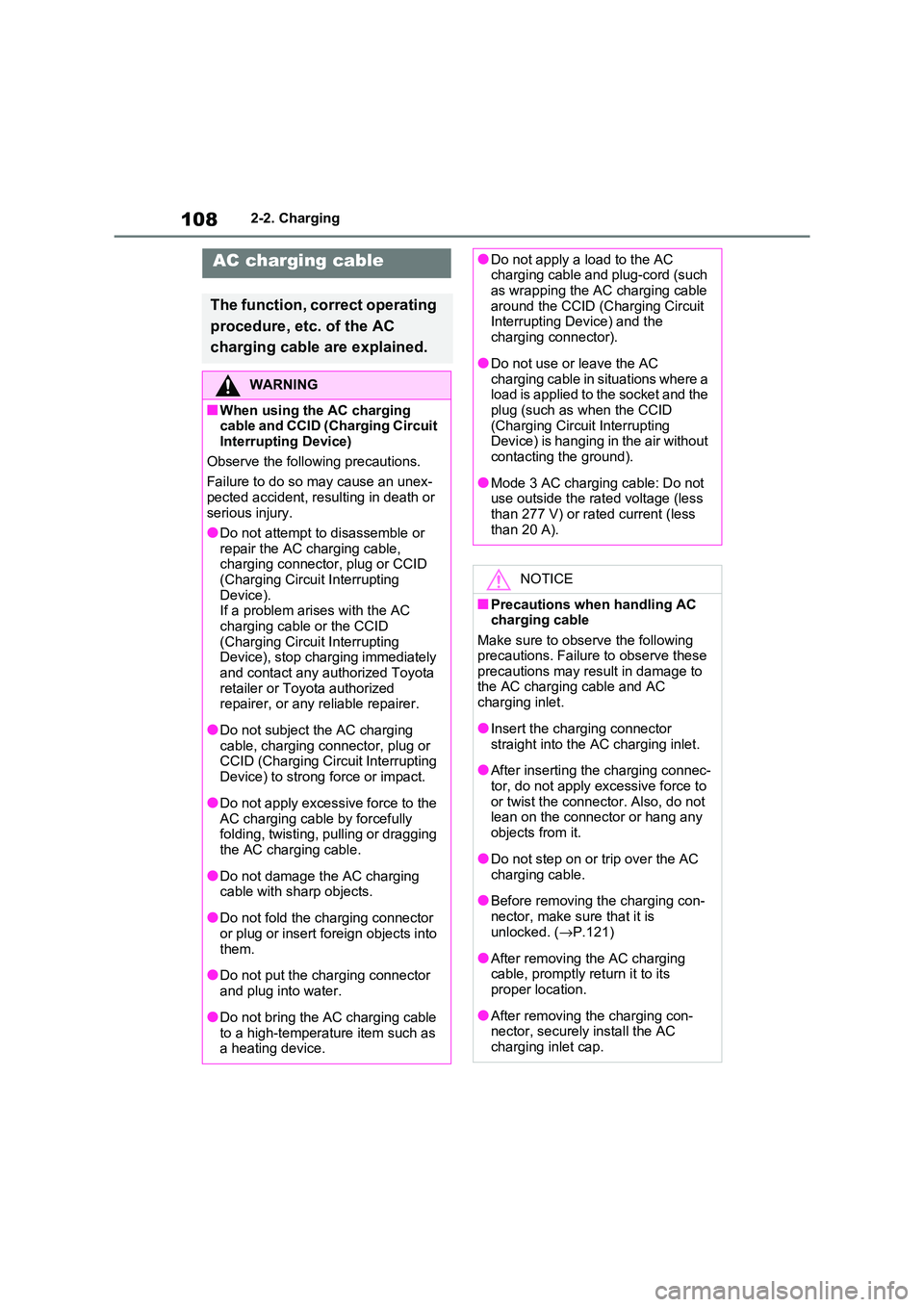
1082-2. Charging
AC charging cable
The function, correct operating
procedure, etc. of the AC
charging cable are explained.
WARNING
■When using the AC charging
cable and CCID (Charging Circuit
Interrupting Device)
Observe the following precautions.
Failure to do so may cause an unex -
pected accident, resulting in death or serious injury.
●Do not attempt to disassemble or
repair the AC charging cable, charging connector, plug or CCID
(Charging Circuit Interrupting
Device). If a problem arises with the AC
charging cable or the CCID
(Charging Circuit Interrupting Device), stop charging immediately
and contact any authorized Toyota
retailer or Toyota authorized repairer, or any reliable repairer.
●Do not subject the AC charging cable, charging connector, plug or
CCID (Charging Circuit Interrupting
Device) to strong force or impact.
●Do not apply excessive force to the
AC charging cable by forcefully folding, twisting, pulling or dragging
the AC charging cable.
●Do not damage t he AC charging
cable with sharp objects.
●Do not fold the ch arging connector
or plug or insert foreign objects into
them.
●Do not put the ch arging connector
and plug into water.
●Do not bring the AC charging cable
to a high-temperature item such as a heating device.
●Do not apply a load to the AC charging cable and plug-cord (such
as wrapping the AC charging cable
around the CCID (C harging Circuit Interrupting Device) and the
charging connector).
●Do not use or leave the AC
charging cable in situations where a
load is applied to the socket and the plug (such as when the CCID
(Charging Circui t Interrupting
Device) is hanging in the air without contacting the ground).
●Mode 3 AC charging cable: Do not use outside the ra ted voltage (less
than 277 V) or rated current (less
than 20 A).
NOTICE
■Precautions when handling AC charging cable
Make sure to observe the following
precautions. Failure to observe these precautions may result in damage to
the AC charging cable and AC
charging inlet.
●Insert the charging connector
straight into the AC charging inlet.
●After inserting th e charging connec-
tor, do not apply excessive force to or twist the connec tor. Also, do not
lean on the connector or hang any
objects from it.
●Do not step on or trip over the AC
charging cable.
●Before removing the charging con -
nector, make sure that it is unlocked. ( →P.121)
●After removing the AC charging cable, promptly return it to its
proper location.
●After removing the charging con -
nector, securely install the AC
charging inlet cap.
Page 111 of 666
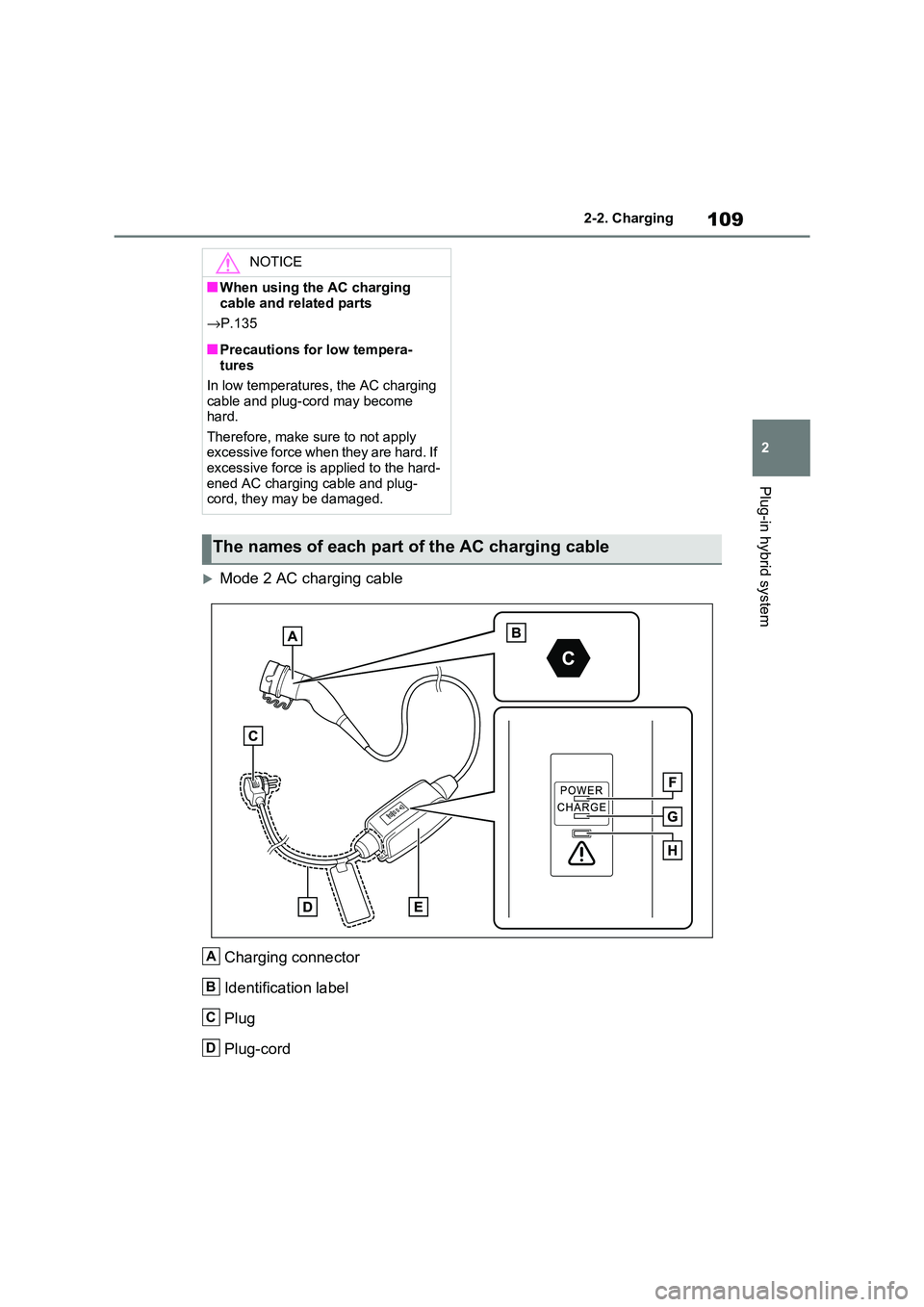
109
2
2-2. Charging
Plug-in hybrid system
Mode 2 AC charging cable
Charging connector
Identification label
Plug
Plug-cord
NOTICE
■When using the AC charging
cable and related parts
→ P.135
■Precautions for low tempera-
tures
In low temperatures, the AC charging
cable and plug-cord may become
hard.
Therefore, make su re to not apply excessive force when they are hard. If
excessive force is applied to the hard -
ened AC charging cable and plug- cord, they may be damaged.
The names of each part of the AC charging cable
A
B
C
D
Page 112 of 666
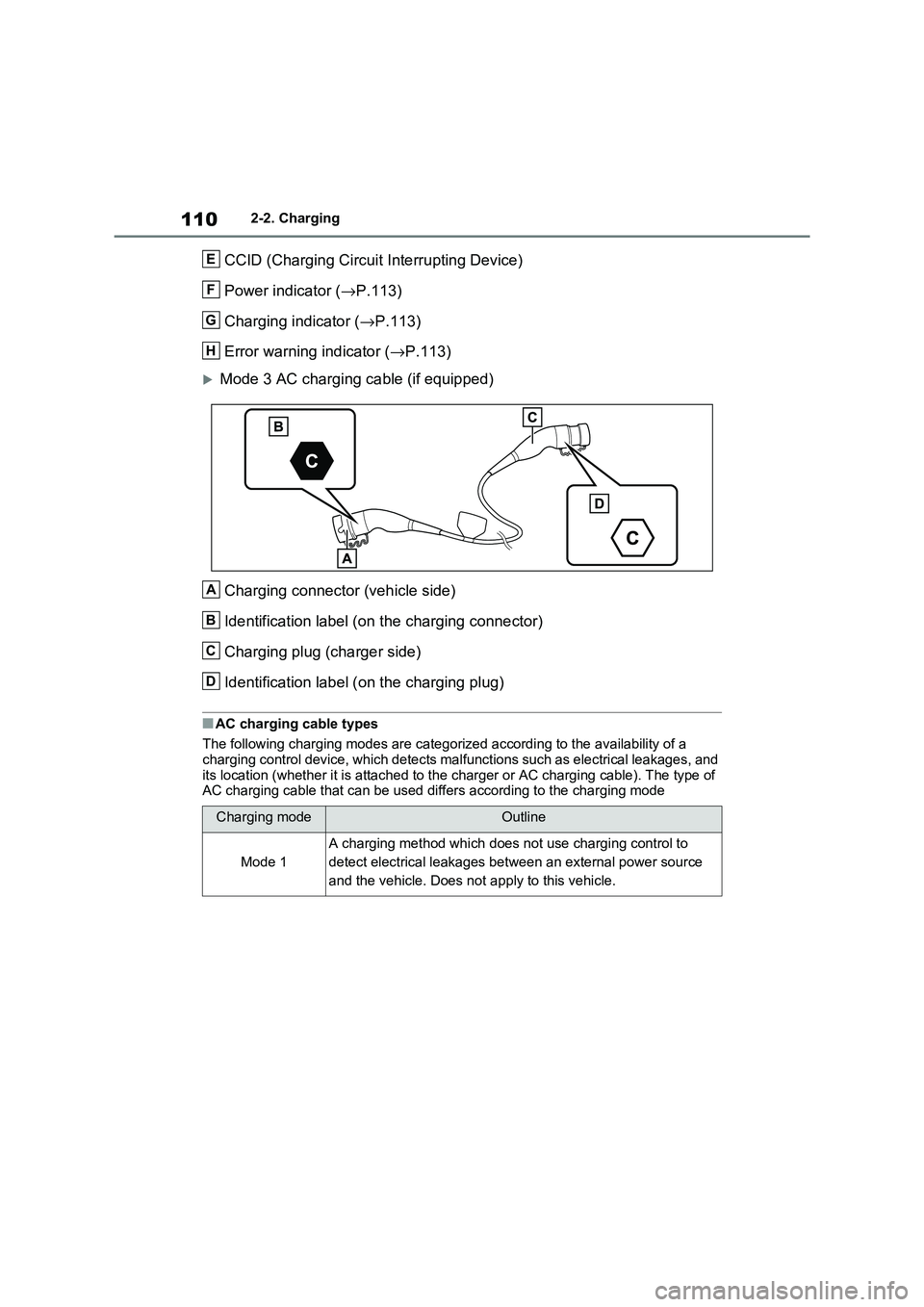
1102-2. Charging
CCID (Charging Circuit Interrupting Device)
Power indicator ( →P.113)
Charging indicator ( →P.113)
Error warning indicator ( →P.113)
Mode 3 AC charging cable (if equipped)
Charging connector (vehicle side)
Identification label (on the charging connector)
Charging plug (charger side)
Identification label ( on the charging plug)
■AC charging cable types
The following charging modes are categorized according to the availability of a charging control device, which detects malfunctions such as ele ctrical leakages, and
its location (whether it is attach ed to the charger or AC charging cable). The type of
AC charging cable that can be us ed differs according to the charging mode
Charging modeOutline
Mode 1
A charging method which does not use charging control to
detect electrical leakages bet ween an external power source
and the vehicle. Does no t apply to this vehicle.
E
F
G
H
A
B
C
D
Page 113 of 666
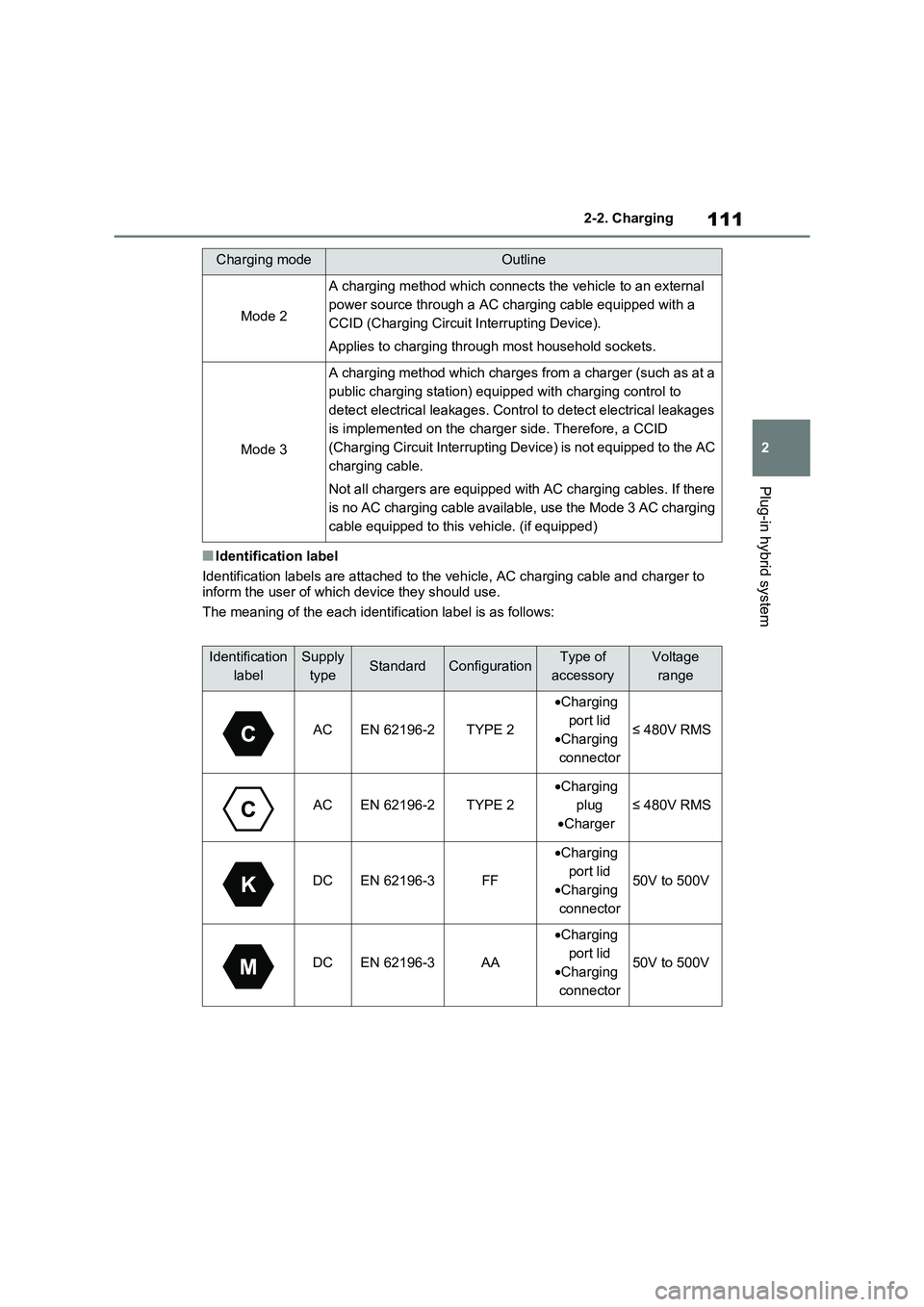
111
2
2-2. Charging
Plug-in hybrid system
■Identifica tion label
Identification labels are attac hed to the vehicle, AC charging cable and charger to inform the user of which device they should use.
The meaning of the each identif ication label is as follows:
Mode 2
A charging method which connects the vehicle to an external
power source through a AC c harging cable equipped with a
CCID (Charging Circuit Interrupting Device).
Applies to charging through most household sockets.
Mode 3
A charging method which charges from a charger (such as at a
public charging station) equip ped with charging control to
detect electrical leakages. Control to detect electrical leakag es
is implemented on the charge r side. Therefore, a CCID
(Charging Circuit Interrupting Device) is not equipped to the A C
charging cable.
Not all chargers are equipped with AC charging cables. If there
is no AC charging cable available, use the Mode 3 AC charging
cable equipped to this vehicle. (if equipped)
Identification
label
Supply
typeStandardConfigurationType of
accessory
Voltage
range
ACEN 62196-2TYPE 2
• Charging
port lid
• Charging
connector
≤ 480V RMS
ACEN 62196-2TYPE 2
• Charging
plug
• Charger
≤ 480V RMS
DCEN 62196-3FF
•Charging
port lid
• Charging
connector
50V to 500V
DCEN 62196-3AA
• Charging
port lid
• Charging
connector
50V to 500V
Charging modeOutline
Page 114 of 666
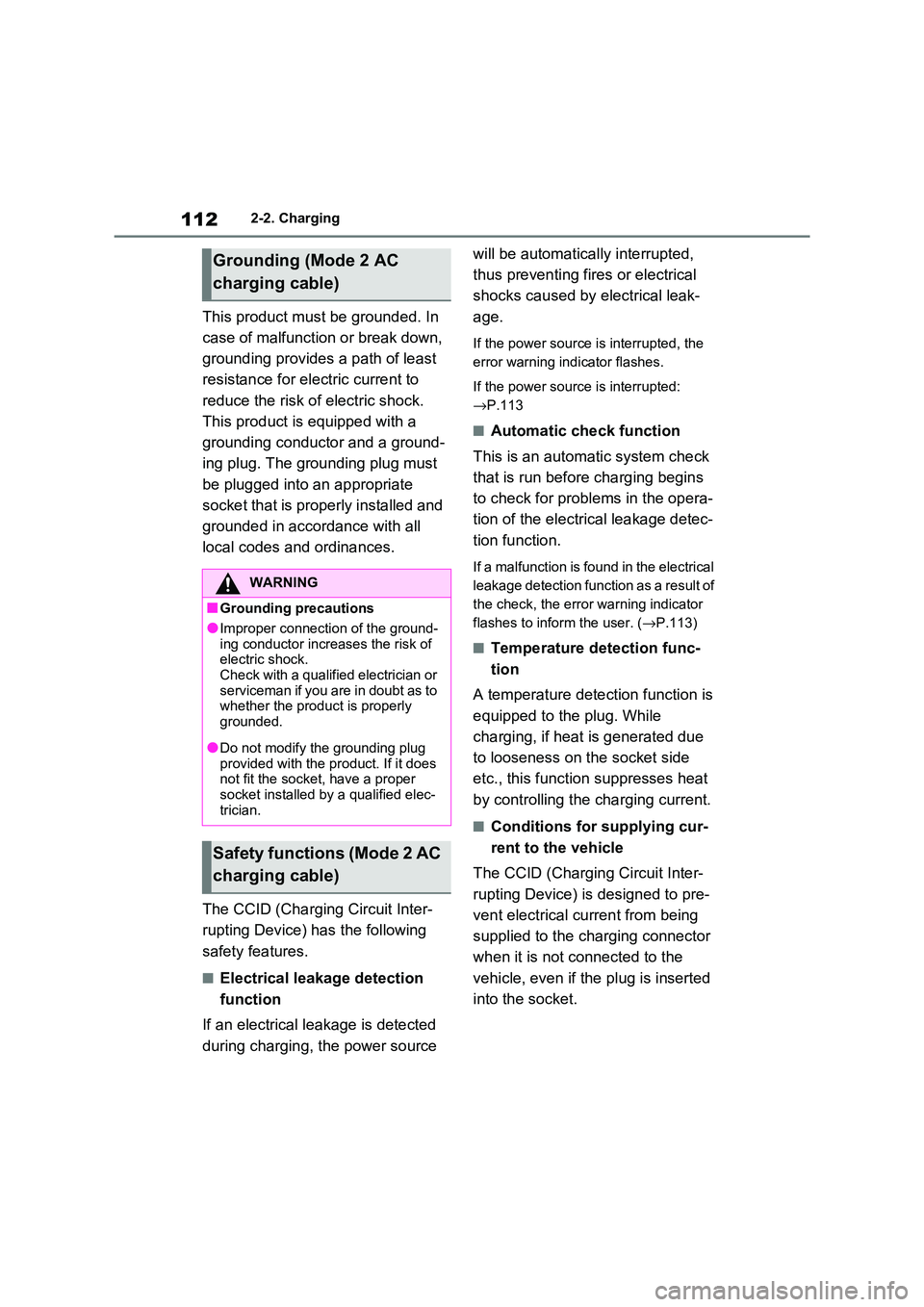
1122-2. Charging
This product must be grounded. In
case of malfunction or break down,
grounding provides a path of least
resistance for electric current to
reduce the risk of e lectric shock.
This product is equipped with a
grounding conductor and a ground -
ing plug. The gro unding plug must
be plugged into an appropriate
socket that is properly installed and
grounded in accordance with all
local codes and ordinances.
The CCID (Chargin g Circuit Inter-
rupting Device) has the following
safety features.
■Electrical leakage detection
function
If an electrical l eakage is detected
during charging, the power source
will be automatically interrupted,
thus preventing fires or electrical
shocks caused by electrical leak -
age.
If the power source i s interrupted, the
error warning indicator flashes.
If the power source is interrupted:
→ P.113
■Automatic check function
This is an automatic system check
that is run before charging begins
to check for problems in the opera -
tion of the electrical leakage detec -
tion function.
If a malfunction is found in the electrical
leakage detection function as a result of
the check, the error warning indicator
flashes to inform the user. ( →P.113)
■Temperature detection func-
tion
A temperature detection function is
equipped to the plug. While
charging, if heat is generated due
to looseness on the socket side
etc., this function suppresses heat
by controlling the charging current.
■Conditions for supplying cur -
rent to the vehicle
The CCID (Charging Circuit Inter -
rupting Device) is designed to pre-
vent electrical cu rrent from being
supplied to the ch arging connector
when it is not connected to the
vehicle, even if the plug is inserted
into the socket.
Grounding (Mode 2 AC
charging cable)
WARNING
■Grounding precautions
●Improper connection of the ground -
ing conductor increases the risk of electric shock.
Check with a qualified electrician or
serviceman if you are in doubt as to whether the product is properly
grounded.
●Do not modify t he grounding plug
provided with the product. If it does
not fit the socket, have a proper socket installed by a qualified elec -
trician.
Safety functions (Mode 2 AC
charging cable)
Page 115 of 666

113
2
2-2. Charging
Plug-in hybrid system
■Indicator operation
3 indicators are used to indicate the
following conditions.
Power indicator
Illuminates when electricity is flowing to
the CCID (Charging Cir cuit Interrupting
Device).
Charging indicator
Illuminates when charging is in prog -
ress.
Error warning indicator
Flashes when there is an electrical
leakage or when a malfunction occurs
in the CCID (Charging Circuit Interrupt-
ing Device).
■When a malfunction occurs during charging
The indicators on the CCID (Char ging Circuit Interrupting Device) use a
combination of different statu ses (not illuminated, illuminated or flashing) to
inform the user of internal malfunctions.
When the error warning indicato r is illuminated or flashing, temporarily remove the
plug from the socket and then re connect it to check if the error indicator turns off.
If the error warning indicator turns off, charging is now possible.
If it does not turn off, perform the correction procedure in the following chart.
CCID (Charging Circuit Inter-
rupting Device) indicators
(Mode 2 AC charging cable)
A
B
C
StatusPower indica -
tor
Error warning
indicatorCause/Correction procedure
Charging system
error
Not illuminated
Not illumi -
nated or illumi -
nated
An electrical leakage is
detected and charging is can -
celed, or there is a malfunction
in the AC charging cable.
→ Consult any authorized
Toyota retailer or Toyota
authorized repairer, or any
reliable repairer
IlluminatedFlashes
Page 116 of 666

1142-2. Charging
*1: When this occurs, charging is carried out without a limited charging current.
*2: When this occurs, charging is carried out with a limited charging current.
Plug temperature
detection mal -
function
FlashesFlashes
There is a malfunction in the
plug temperature detection
part.*1
→ Consult any authorized
Toyota retailer or Toyota
authorized repairer, or any
reliable repairer
Plug temperature
increase detectionFlashesNot illuminated
An increase in the temperature
of the plug is de tected due to
an improper connection
between the socket and plug.*2
→ Check that the plug is
securely connected to the
socket
AC charging cable
life span noticeIlluminatedFlashes
The number of charges using
the AC charging cable is near -
ing the end of its usable life
span.
→ Consult any authorized
Toyota retailer or Toyota
authorized repairer, or any
reliable repairer
AC charging cable
life spanIlluminatedIlluminated
The number of charges using
the AC charging cable has
exceeded its usable number of
charges.
→ Consult any authorized
Toyota retailer or Toyota
authorized repairer, or any
reliable repairer
StatusPower indica -
tor
Error warning
indicatorCause/Correction procedure
Page 117 of 666
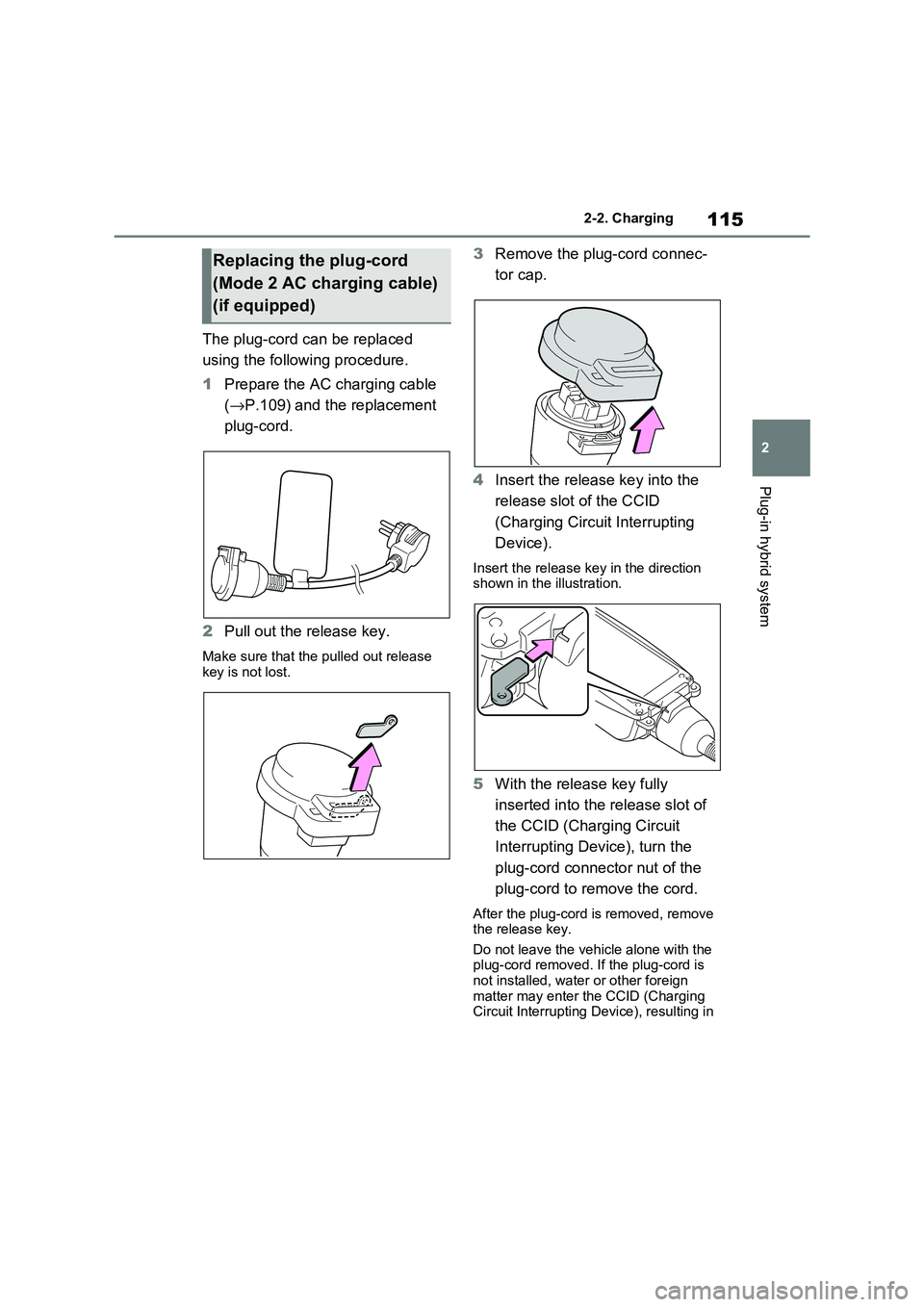
115
2
2-2. Charging
Plug-in hybrid system
The plug-cord can be replaced
using the following procedure.
1 Prepare the AC charging cable
( →P.109) and the replacement
plug-cord.
2 Pull out the release key.
Make sure that the pulled out release key is not lost.
3 Remove the plug-cord connec-
tor cap.
4 Insert the release key into the
release slot of the CCID
(Charging Circuit Interrupting
Device).
Insert the release k ey in the direction shown in the illustration.
5 With the release key fully
inserted into the release slot of
the CCID (Charging Circuit
Interrupting Device), turn the
plug-cord connector nut of the
plug-cord to remove the cord.
After the plug-cord is removed, remove the release key.
Do not leave the vehicle alone with the
plug-cord removed. If the plug-cord is not installed, water or other foreign
matter may enter the CCID (Charging
Circuit Interrupting Device), resulting in
Replacing the plug-cord
(Mode 2 AC charging cable)
(if equipped)
Page 118 of 666

1162-2. Charging
a malfunction.
6 Align the protrusion of the CCID
(Charging Circuit Interrupting
Device), with the groove of the
plug-cord, insert the plug-cord
into the CCID (Charging Circuit
Interrupting Devi ce), and then
turn the plug-cord connector nut
of the plug-cord to install it.
Make sure that there are no foreign
objects attached to the connection
before installing the plug-cord. Remove any foreign objects if they are attached.
Otherwise, water or other foreign mat -
ter may enter the CCID (Charging Cir - cuit Interrupting Devi ce), resulting in a
malfunction.
Turn the plug-cord connector nut of the plug-cord in the opposite direction of
removal until a click sound is heard and
the plug-cord is secured.
7 Install the plug-cord connector
cap and release key to the plug-
cord that has been removed.
Securely install the release key to the
plug-cord connector cap to prevent it from being lost. Als o, make sure that
the release key does not fall out of the
plug-cord connector cap accidentally.
Store the plug-cord in a safe, clean and
dry place.
WARNING
■When replacing the plug-cord (if
equipped)
Check the following points regularly.
Failure to do so may cause an unex -
pected accident, resulting in death or serious injury.
●Do not replace th e plug-cord with wet hands.
Also, do not replace in a place that
is rainy or wet.
●Do not replace the plug-cord when
the plug and/or charging connector are connected.
●Check whether there are any local EV-charging regulations in place,
and adhere to them.
Page 119 of 666
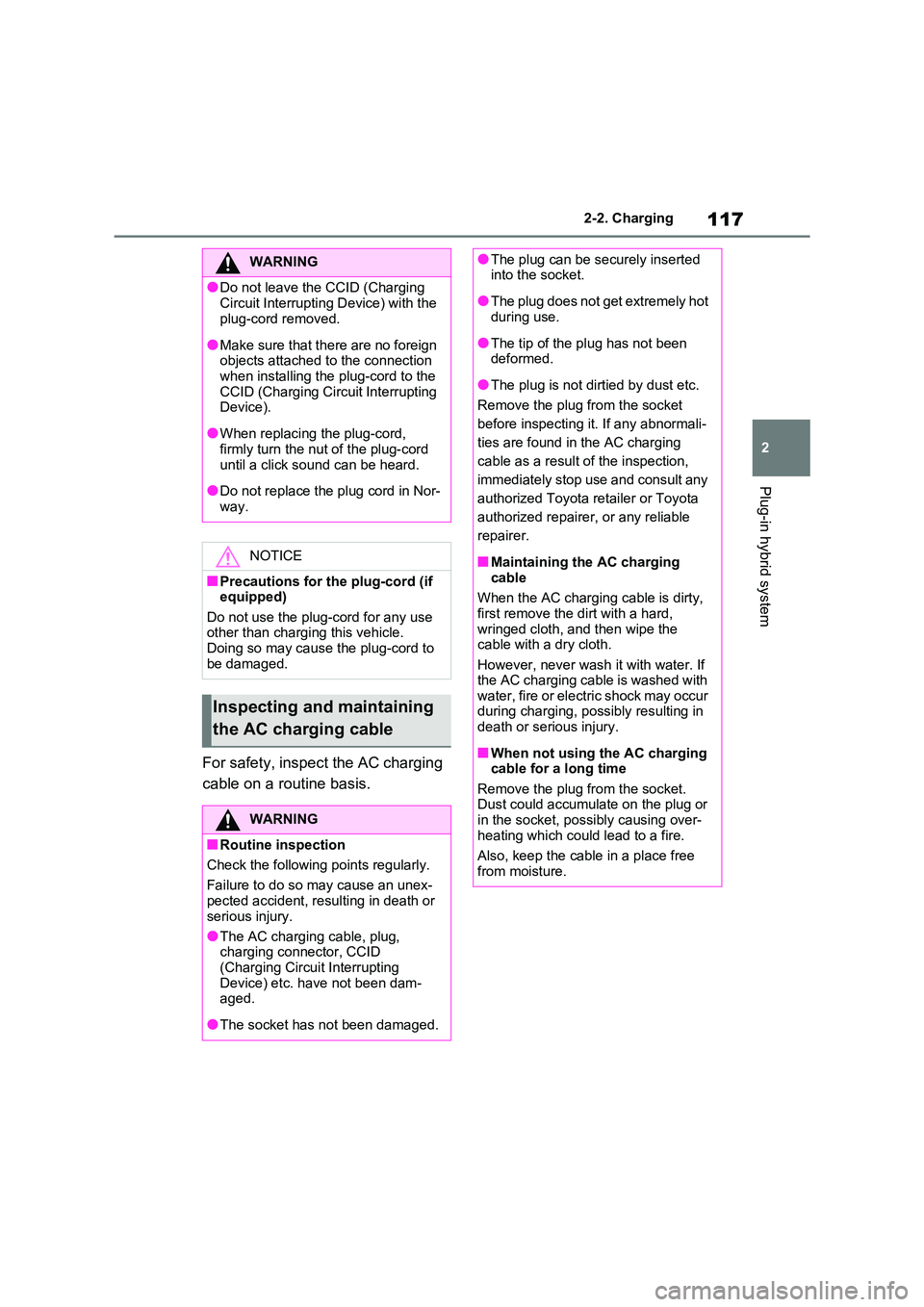
117
2
2-2. Charging
Plug-in hybrid system
For safety, inspect the AC charging
cable on a routine basis.
WARNING
●Do not leave t he CCID (Charging
Circuit Interrupting Device) with the
plug-cord removed.
●Make sure that there are no foreign
objects attached to the connection when installing the plug-cord to the
CCID (Charging Circuit Interrupting
Device).
●When replacing the plug-cord,
firmly turn the nut of the plug-cord
until a click so und can be heard.
●Do not replace the plug cord in Nor-
way.
NOTICE
■Precautions for the plug-cord (if
equipped)
Do not use the plug- cord for any use other than charging this vehicle.
Doing so may cause the plug-cord to
be damaged.
Inspecting and maintaining
the AC charging cable
WARNING
■Routine inspection
Check the following points regularly.
Failure to do so may cause an unex - pected accident, resulting in death or
serious injury.
●The AC charging cable, plug,
charging connector, CCID (Charging Circuit Interrupting
Device) etc. have not been dam -
aged.
●The socket has not been damaged.
●The plug can be securely inserted into the socket.
●The plug does not get extremely hot during use.
●The tip of the pl ug has not been deformed.
●The plug is not dirtied by dust etc.
Remove the plug from the socket
before inspecting it. If any abnormali -
ties are found in the AC charging
cable as a result of the inspection,
immediately stop use and consult any
authorized Toyota retailer or Toyota
authorized repairer, or any reliable
repairer.
■Maintaining th e AC charging cable
When the AC chargi ng cable is dirty,
first remove the d irt with a hard, wringed cloth, and then wipe the
cable with a dry cloth.
However, never wash it with water. If the AC charging cable is washed with
water, fire or electric shock may occur
during charging, possibly resulting in death or serious injury.
■When not using the AC charging cable for a long time
Remove the plug from the socket.
Dust could accumulate on the plug or in the socket, po ssibly causing over-
heating which coul d lead to a fire.
Also, keep the cable in a place free from moisture.